Asscher Cut Diamonds and Engagement Rings: Beyond the Basics
When it comes to distinctive diamonds, there is really no other shape quite as unique or eye-catching as the Asscher cut (note the capital "a", but we'll get to that later), long a favorite of celebrities, royals, and the super sophisticated among us. The Asscher cut's unique vintage charm is only matched by its modern, geometric appeal. But what exactly is it that makes this diamond shape so special and captivating? Consider this your in-depth guide to the Asscher cut diamond: it's history, characteristics, and what you need to consider when you're indulging in buying your very own Asscher cut diamond engagement ring.
What is an Asscher Cut Diamond?
For starters, the Asscher cut is a square-shaped diamond with cropped corners, often referred to as a square emerald cut. "Square emerald cut" is also how you'll see this shape described on any diamond grading report, so keep that in mind as you're scanning the internet for details. Both diamond shapes — Asscher diamonds and emerald cut diamonds — are what we call "step cut" diamonds. Unlike other diamond shapes that rock brilliant facets that radiate outward like the spokes of a wheel, step cut facets are arranged like concentric rectangles (in an emerald cut diamond) and concentric squares (in an Asscher cut). This lends step cuts a mesmerizing geometric precision and unique play of light that is less bright white sparkle and more big, captivating, rainbow flash.
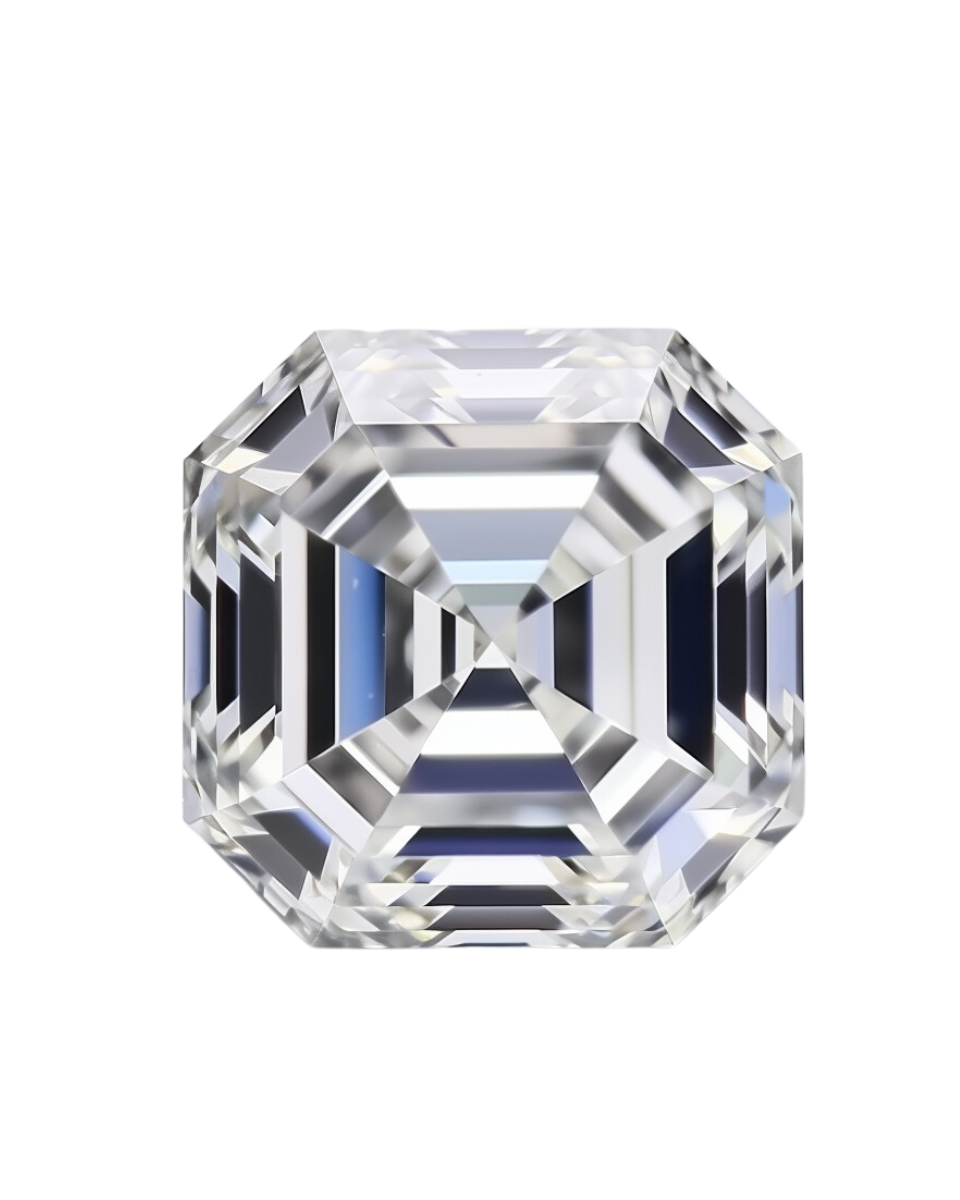
Like an emerald cut but square
History of the Asscher Cut
While the Asscher cut diamond we know and love today looks completely modern, this stunning diamond cut was first introduced to the world by the renowned Asscher Brothers of Asscher Diamond Company in Holland in 1902. Already a well-known diamond cutting company, it was in this year that Joseph Asscher perfected the geometric lines and facets of this unique square cut diamond. In fact, it was so unique that it held the world's first diamond cut patent. When the Asscher Diamond Company lost the patent during the height of WWII, it became a style available the world over, evolving into its contemporary variations yet always maintaining its distinctive aesthetic.
The Asscher cut shape has become known for its particularly famous appearances including the Imperial State Crown of England and the Krupp diamond given to Elizabeth Taylor by husband Richard Burton. The stone shape also makes excellent use of the rough octahedral diamond shape (the crystal in it's natural form), meaning less carat weight is lost in the cutting process than with other styles of cutting. Now known as the Royal Asscher Diamond Company, the family has earned a new "Royal Asscher Cut" patent for an updated version of this shape, but other diamond cutters can also still cut their own version of the original Asscher cut.
Defining the Shape of Asscher Cut Diamonds
The Asscher cut diamond is characterized by a square shape with cropped corners, resembling a sort of octagon. It typically has a high crown, a small table, and a deep pavilion. The cut's unique facet arrangement creates a mesmerizing hall of mirrors effect, providing exceptional brilliance and fire, yet it is still a bit quieter than its brilliant cut diamond counterparts.
When you look into the top of a well-cut Asscher cut diamond, you should see a very even "X" shape through the stone, from the cropped corners down to the culet point at the very bottom of the diamond shape.
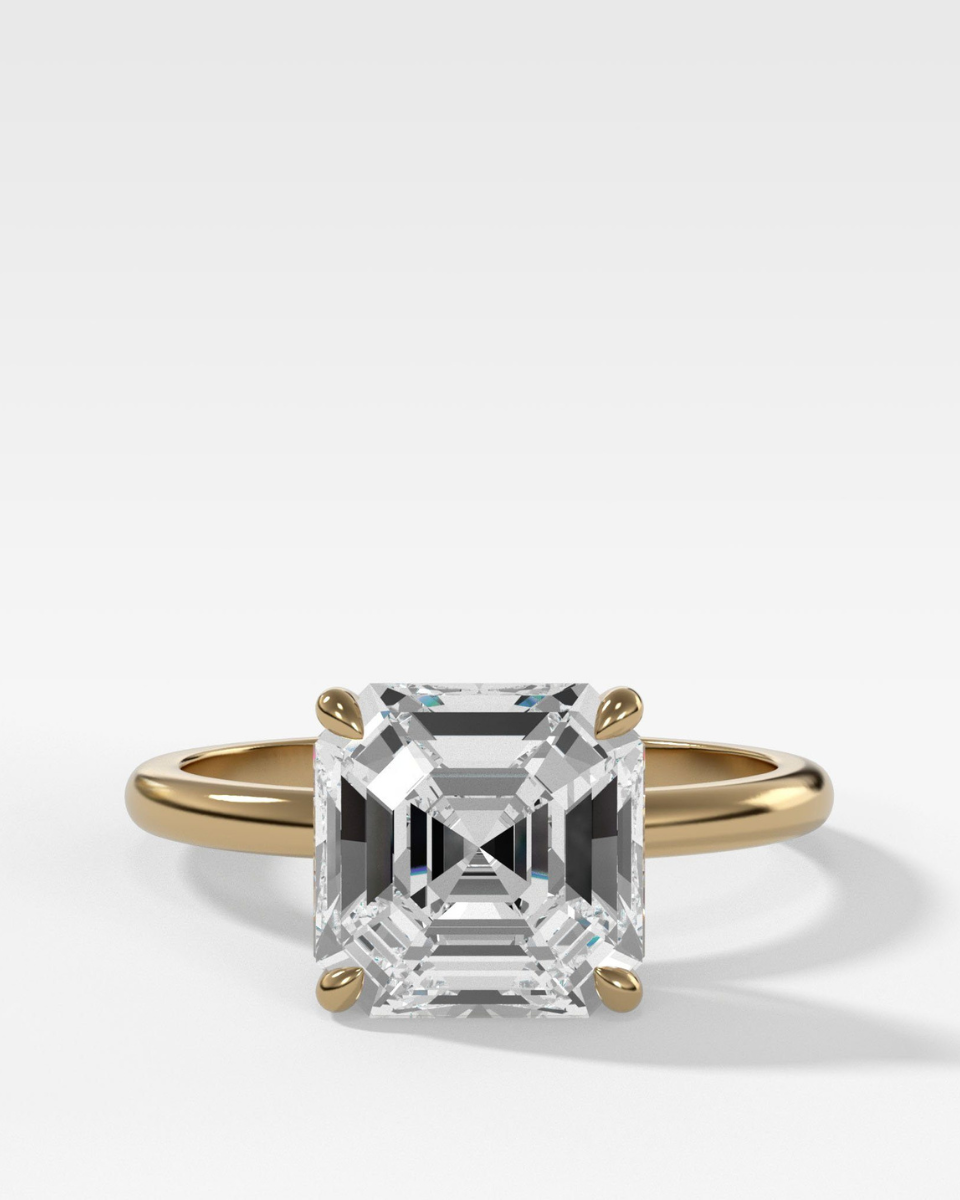
The most delicate way to sport an asscher cut - our Thin & Simple solitaire engagement ring
The Difference Between an Asscher and a Cushion cut diamond
Often considered in the decision making process as somewhat similar, when given close inspection the asscher cut and the cushion cut diamond are quite different. For one, the Asscher cut is all about straight lines and sharp geometry. The cushion cut on the other hand is curvy and rounded from every angle. Cushion cuts also have tiny brilliant facets instead of elongated trapezoid-shaped facets. The square shape of an Asscher is also a defining feature, while a cushion can be a rounded square or more elongated like emerald cuts.
A princess cut diamond is also a brilliant cut stone that, yes, is square, but has a completely different faceting pattern than the Asscher cut and sharp, pointed corners instead of trimmed. And emerald cuts are essentially the elongated version of an Asscher, so rectangular shape instead of square shape.
The Importance of Asscher Cut Proportions
Because Asscher cut diamonds have elongated, very geometric facets, and this concentric pattern, the cut grade and proportions of a stone are quite important to its visual appearance and light performance. After all, no one wants to look into a dazzling diamond only to see something looks a bit off kilter, no? But because Asscher cuts — like all fancy shapes — do not have an industry-standardized cut grade, it's important to know what to look for.
Check out an Asscher cut diamond's symmetry grade to ensure you're looking at an "excellent" stone, and look for well-balanced proportions to ensure optimal brilliance and that extra sparkle we all crave. The table percentage, crown height, and pavilion depth are critical factors to consider. A moderate depth percentage (around 65-75%) is generally preferred for Asscher cut diamonds, as it contributes to a balanced appearance.
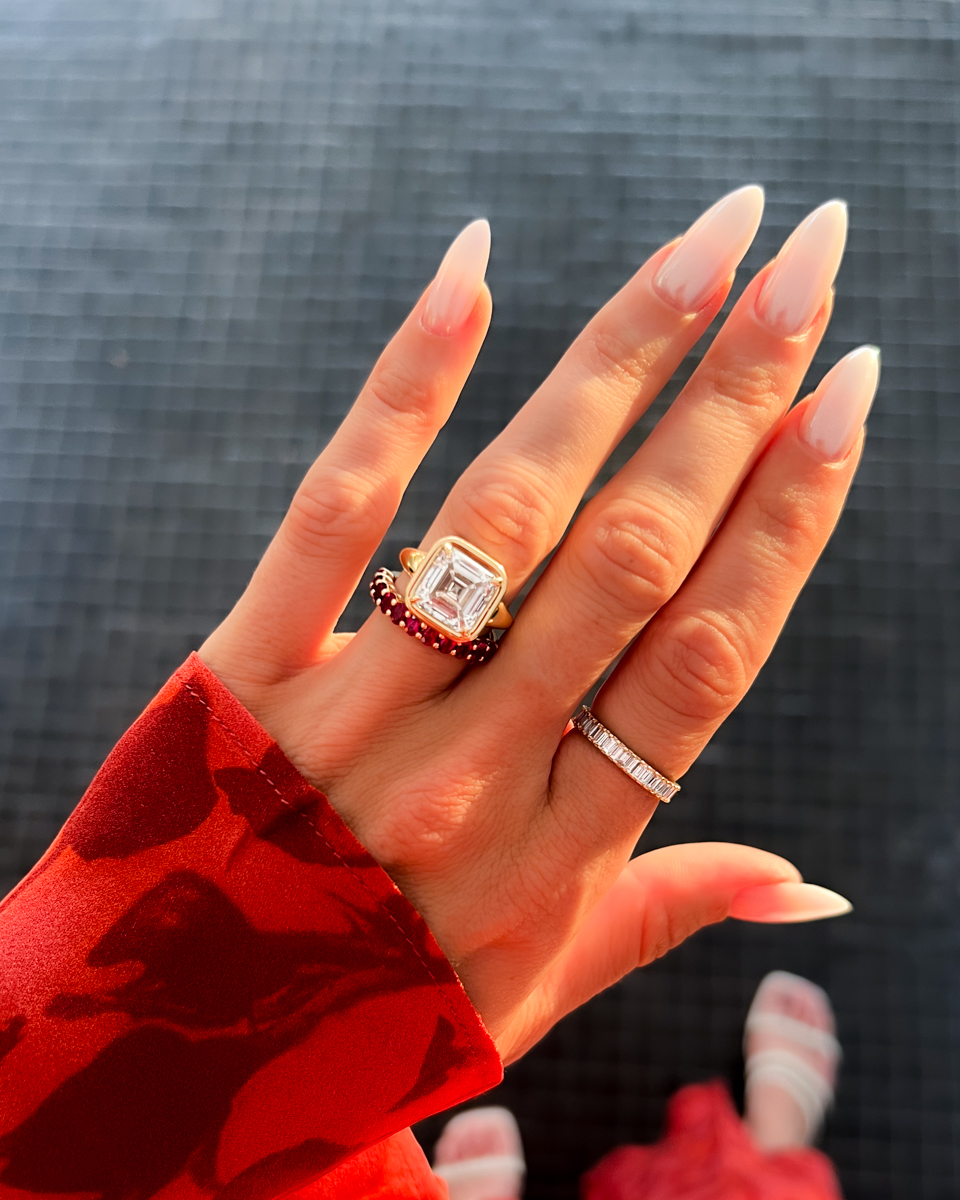
Over dainty? The Club ring adds the minimalism of bezel settings to a chunky ring
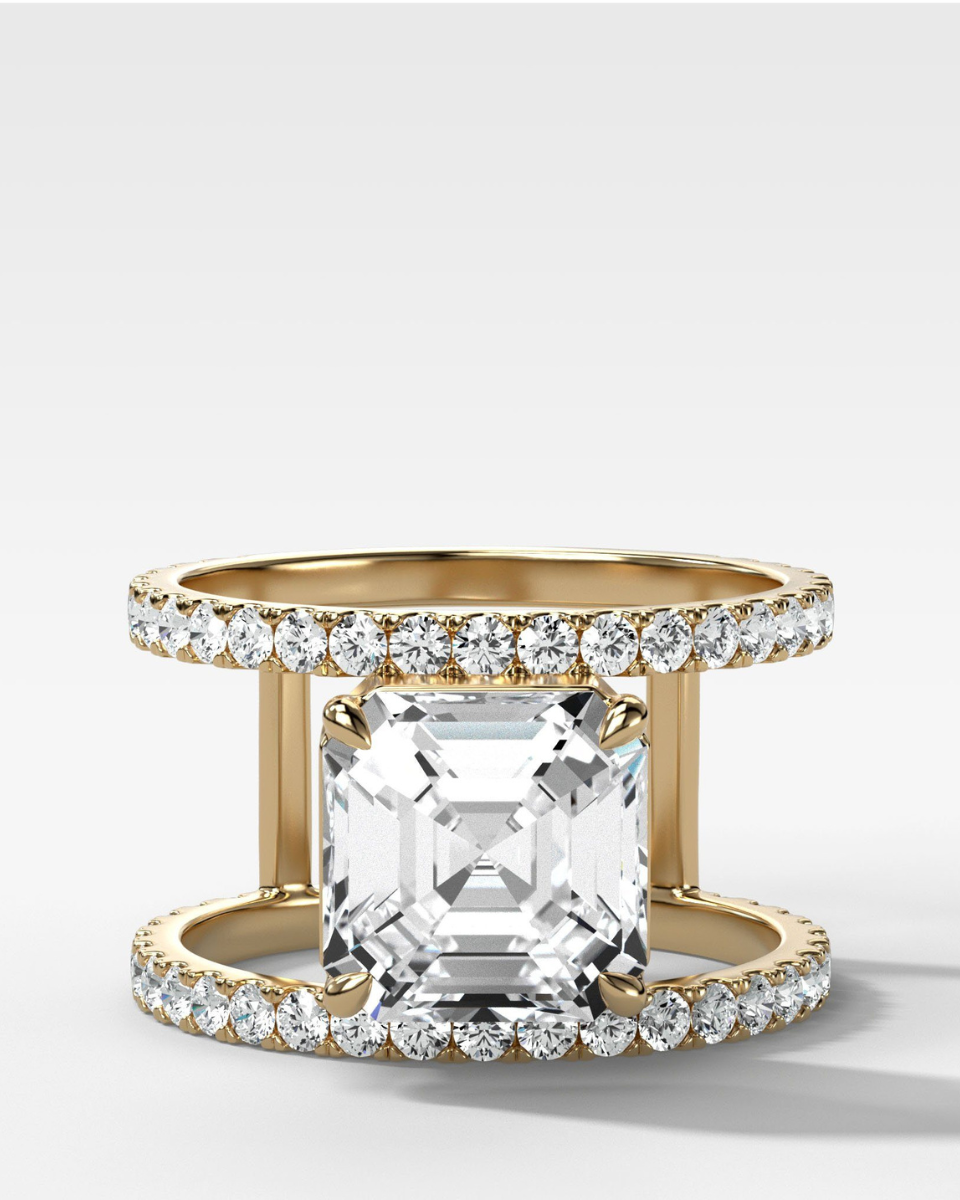
Double Row Gap ring with an Asscher cut diamond
The 4Cs of an Asscher Cut Diamond: Know Before You Buy
In addition to finding an Asscher cut with excellent polish, symmetry, and proportions, there are a few Asscher cut diamond features to keep in mind when looking for your dream diamond.
-
Clarity: The step-cut facets of an Asscher diamond cut make inclusions more noticeable. They are wider and more open than round brilliant diamonds, and don't break up the light reflections quite so much. This means that you'll likely want to select a higher clarity grade (which can cost more money) to ensure that your diamond is eye-clean. Typically a VS1 or VS2 is still ok, but it is recommended that you look at photos or video of any potential diamonds to see for yourself before you spend.
-
Color: While color is a matter of personal preference, there are some diamond cuts that simply hide or display diamond color more than others. Asscher cut facets don't hide the diamond's body color as well as brilliant facets, but you can find really well-balanced diamonds in the G-H color range that still give you a bright appearance and affordable budget.
-
Cut: With all diamond shapes, cut quality should be your highest priority, as it's the C with the most impact on a diamond's visual appearance and sparkle. An uneven or poorly cut diamond simply won't look great, no matter what. You'll want to opt for a well-proportioned Asscher cut that maximizes the stone's light performance and minimizes the visibility of inclusions. You want all those little reflective mirrors to really shine in a nice, even way to the naked eye, fully displaying the clean lines and nice even cut corners of your Asscher cut diamond.
-
Carat Weight: Again, the Asscher cut tends to showcase the diamond's carat weight effectively, giving you a nice even looking diamond for its weight, despite having slightly thick bellies and deep pavilions. While a larger carat weight can enhance the stone's presence, balance is crucial to ensure a harmonious appearance. Don't prioritize carat weight over cut. For instance, a 1 carat Asscher diamond that is well cut can even look larger than a poorly cut stone of a higher carat weight.
Styles of Asscher Cut Diamond Engagement Rings
Putting your Asscher cut diamond on full display can be fit to nearly any style preferences, though there are some engagement rings that showcase its inherent distinctive asscher cut diamond qualities better than others. Art Deco inspired styles, for instance, with their clean lines and geometric appeal, play particularly well with Asscher cuts. Here are some other ideas:
-
Solitaire Rings: The simplicity of a solitaire setting (which features a single center stone set into a band of nearly any style) allows the Asscher cut diamond to take center stage, showcasing its unique beauty without distractions. Solitaires can be quite simple, with a four-prong setting that cradles the diamond set atop a simple band. Or they can be more ornate with engraving, milgrain details, or a split shank, perhaps.
-
Three-Stone Rings: Pairing an Asscher cut with side stones creates a striking look, adding depth and dimension to the overall design. One thing to be aware of when shopping for a three-stone Asscher cut ring, however, is ensuring that your side diamonds and center stone are well matched and proportional so that you have an overall harmonious look.
-
Halo Rings: A halo of smaller diamonds surrounding the asscher cut amplifies its brilliance and provides a glamorous, vintage-inspired look.
-
Pavé Settings: Pavé diamonds — small diamonds set along the band — enhance the overall sparkle and glamour of an Asscher cut diamond engagement ring. It gives your ring just a hint of extra brilliance and can be a great way to add light performance to your ring without going for a major-carat Asscher that blows your budget.
-
Bezel Settings: One of the most modern style settings that we love for an Asscher (because it's less typical with the stone's cut corners) is a bezel, which encircles the Asscher cut diamond with a thin metal rim, offering both protection and a fresh aesthetic.
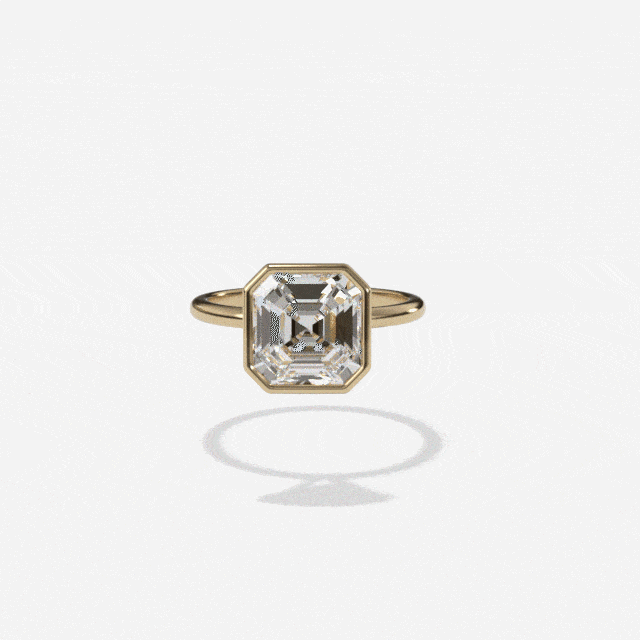
The royal asscher cut diamond in a bezel setting
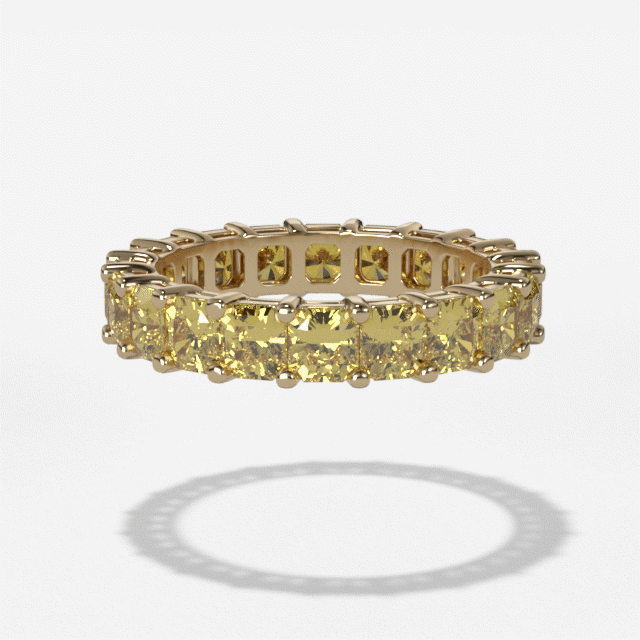
Spice up your diamond ring with some color with Fancy Yellow Asscher cut diamonds & their iconic beveled corners
Finding an Asscher Cut Wedding Band
While certainly less common than a round brilliant cut diamond band, Asscher cuts are popping up everywhere these days in the form of stunning diamond eternity bands and wedding bands you can match to create your perfect bridal set. A bezel-set Asscher cut eternity band works well with many style engagement rings, as the metal bezels protect the edges of the diamonds from causing added wear and tear in a ring stack. Or for a more spaced-out look, try Asscher cut diamonds scattered across just the top of a simple band, nestled next to a solitaire. If you really want to go all out on exploiting an Asscher cut's signature style and color, shop for a fancy colored diamond band like our Asscher Cut Constellation Eternity Band with Yellow Diamonds.
No matter what your style preferences are, the Asscher cut diamond will fit right in, with its vintage charm and contemporary aesthetic. Armed with all of these handy details, you're all set to shop. Explore our collection of Asscher Cut Engagement Rings or jump in with a diamond. Our expert team will help you take all the right considerations into account to source the perfect stone for your enduring symbol of love.
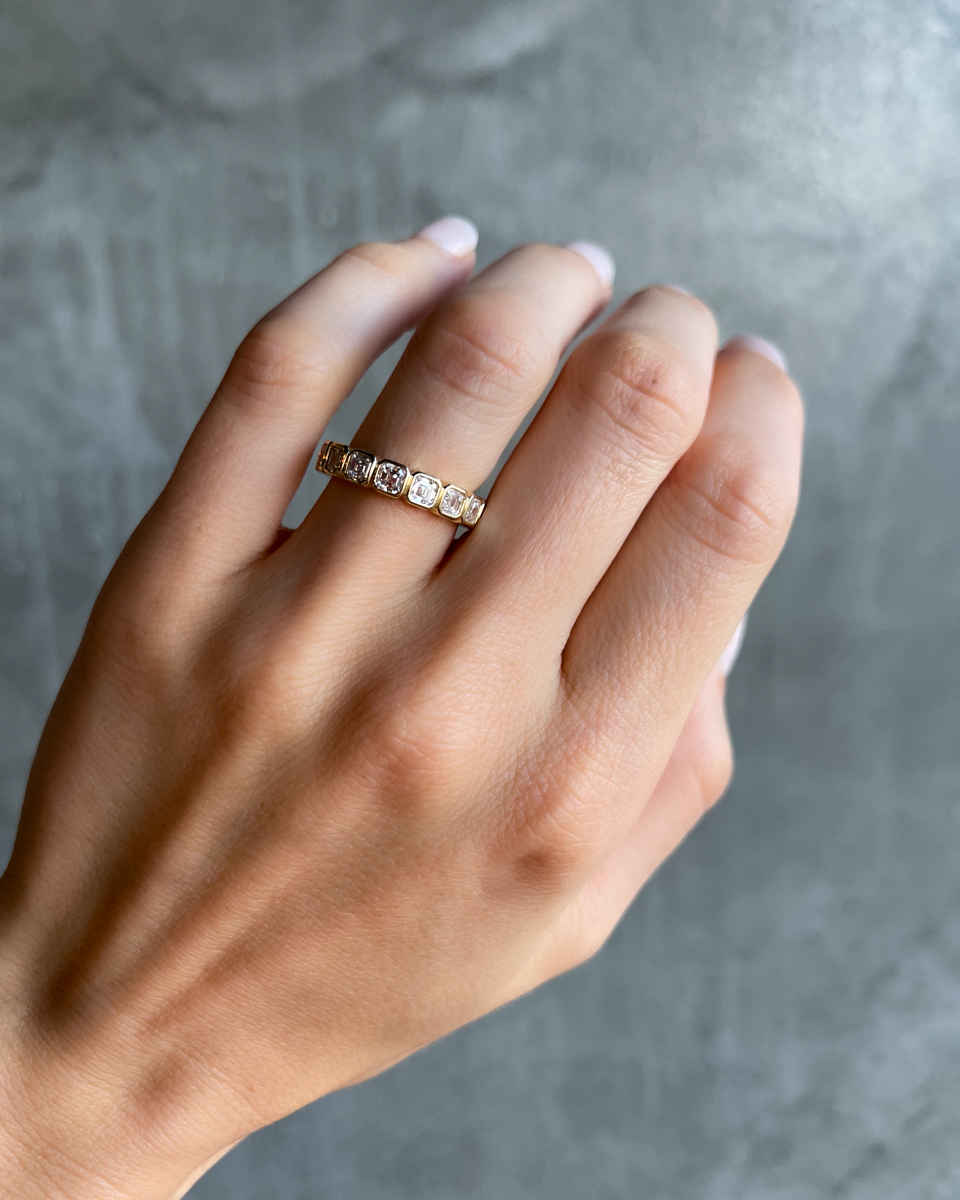
Showing our step facets a little love in a wedding band version of a bezel setting
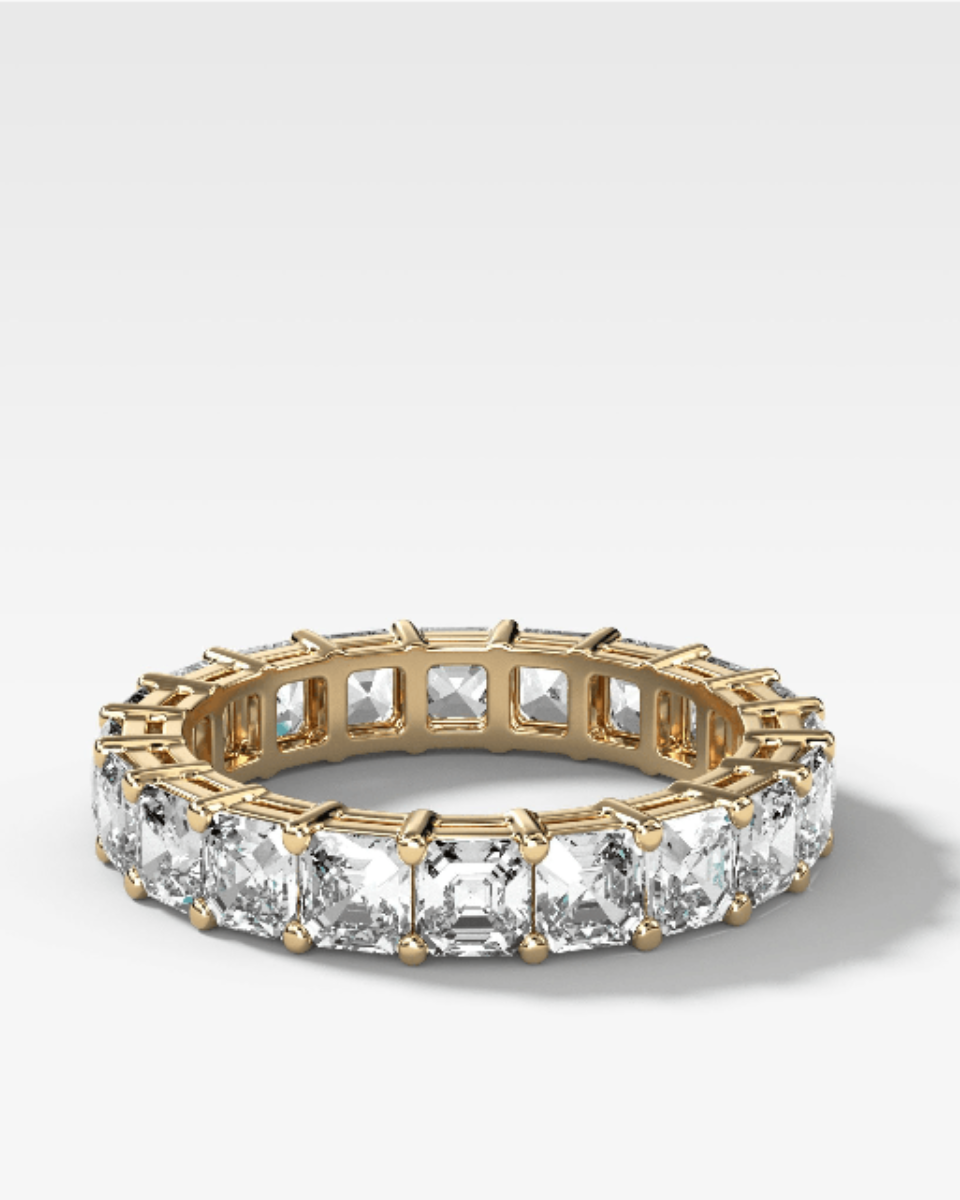
The classic eternity band for any engagement ring shape - our Constellation Shared prong wedding band with Asscher cut diamonds
Enjoy this diamond shape guide? Check our our breakdown on:
- Emerald Cut diamonds
- Radiant Cut diamonds
- Marquise Cut diamonds
- Oval Cut diamonds (coming soon)
- Cushion Cut diamonds (coming soon)
- Pear Cut diamonds (coming soon)
- Round diamonds (coming soon)
- Princess cut diamonds (coming soon)
- Old Mine cut diamonds (coming soon)
- Old Euro cut diamonds (coming soon)








Leave a comment (all fields required)